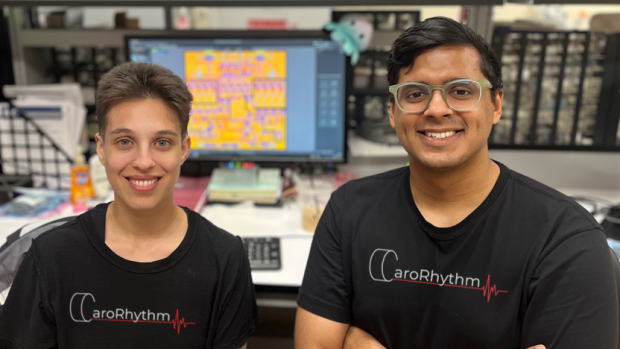Biomedical Engineering chair Andreas Hielscher and his students are partnering with clinicians to predict and mitigate stroke risks
Their non-invasive medical device has won a competitive NYU grant aimed at commercializing technology

Doctoral candidate Nisha Maheshwari and Master's candidate Lokesh Sharma, part of the research team that developed a flexible dynamic optical spectroscopic system that can detect anomalies in blood flow and oxygenation levels
Carotid artery disease occurs when the vessels that deliver blood and oxygen to the brain become clogged, increasing the risk of a stroke. Strokes are now the leading cause of death and disability in the nation, so it’s imperative for physicians to be able to detect problems with blood flow and oxygen levels early on and take steps to correct them.
In mid-2022, personnel from NYU Langone approached Vadim Gordin, who directs the A/X Venture Studio at the NYU Tandon Future Labs, with an idea. A Langone neurologist named Albert Favate, who specializes in intensive care after stroke, had conceived of a new stent (a small tube used to hold open passages in the body, including narrowed arteries). Dr. Favate’s proposal was for the stent to both directly monitor and control blood flow to the brain. Unfortunately, the engineering involved in the device as proposed seemed impossible. Could anyone at Tandon help?
Gordin, whose mission is to help build viable companies from the intellectual property created at the school, knew that Professor Andreas Hielscher, the chair of Tandon’s Department of Biomedical Engineering had won renown for developing new medical imaging technologies to provide information about the blood and oxygen supply in various tissues — work that had proved especially useful in the care of diabetic patients with peripheral artery disease (PAD). Hielscher was also focused on rapidly moving his discoveries from the lab to patient-care settings – a vital mindset when lives are at stake.
After Gordin introduced Dr. Favate to the Hielscher Lab, the research team determined that they could apply the existing technology — which was being used to measure hemodynamics in a patient’s extremities — to monitor oxygenation in the carotid artery. Within 30 days, doctoral candidate Nisha Maheshwari, Research Assistant Professor Alessandro Marone, and others in Hielscher’s lab had fashioned a version of both the hardware and software elements that would be capable of providing a real-time readout of oxygenation in the carotid artery and invited the neurologist to try it for himself.
The demonstration was an unmitigated success, with the clinical, engineering, and entrepreneurial faces of the NYU ecosystem being inspired by one another’s talents and vision to ask “what’s possible?”
Based on the electricity of that first meeting, the Tandon Future Labs hired Tandon BME master’s student Lokesh Sharma (‘24) as a Venture Fellow for the project. The team secured an IRB through NYU Langone for an initial observational study, presented their work at a conference, and submitted a new patent application that was a material departure from both Dr. Hielscher and Dr. Favate’s previous work — all within the first nine months, an exceptionally speedy process in the world of healthcare discoveries.
The research team is developing a flexible dynamic optical spectroscopic system that will non-invasively and non-pharmaceutically monitor and stimulate cerebral blood perfusion. “The quicker a clinician can detect anomalies in blood flow and oxygenation levels, the better the chance that a patient can avoid devastating consequences,” Maheshwari and Sharma explain, “and being able to help develop something with such direct benefit to both patients and physicians is the most gratifying experience imaginable for a biomedical engineering student.”
The team is currently applying for federal grants that will allow them to refine their system, and CaroRhythm recently garnered the year’s sole Technology Acceleration & Commercialization (TAC) Award from the office of NYU’s provost.
“In the short two years that the Venture Studio has existed at NYU, we’ve had the privilege of being the first financial support for 12 teams working to improve a broad range of patient outcomes,” Gordin says. “Of those 12, seven have received follow-on funding outside of Tandon and have collectively secured seven IRB approved pilots with more than 500 collective patient contacts, a pending animal study, and five research publications. Our teams have been recognized with follow-on support from both nationally regarded venture funds and federal agencies in their work to better the human condition, and it seems likely that the CaroRythm team will soon be joining them.”

